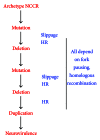Polyomavirus JC in the context of immunosuppression: a series of adaptive, DNA replication-driven recombination events in the development of progressive multifocal leukoencephalopathy
- PMID: 23690820
- PMCID: PMC3649189
- DOI: 10.1155/2013/197807
Polyomavirus JC in the context of immunosuppression: a series of adaptive, DNA replication-driven recombination events in the development of progressive multifocal leukoencephalopathy
Abstract
Polyomavirus JC (JCV) is the etiological agent of progressive multifocal leukoencephalopathy (PML), a demyelinating infection of oligodendrocytes in the brain. PML, a frequently fatal opportunistic infection in AIDS, has also emerged as a consequence of treatment with several new immunosuppressive therapeutic agents. Although nearly 80% of adults are seropositive, JCV attains an ability to infect glial cells in only a minority of people. Data suggest that JCV undergoes sequence alterations that accompany this ability, and these changes can be derived from an archetype strain by mutation, deletion, and duplication. While the introductory source and primary tissue reservoir of JCV remain unknown, lymphoid cells have been identified as potential intermediaries in progression of JCV to the brain. This review is focused on sequence changes in the noncoding control region (NCCR) of the virus. We propose an adaptive mechanism that involves a sequential series of DNA replication-driven NCCR recombination events involving stalled DNA replication forks at NCCR palindromic secondary structures. We shall describe how the NCCR sequence changes point to a model in which viral DNA replication drives NCCR recombination, allowing JCV adaptation to different cell types in its progression to neurovirulence.
Figures




References
-
- Grinnell BW, Padgett BL, Walker DL. Distribution of nonintegrated DNA from JC papovavirus in organs of patients with progressive multifocal leukoencephalopathy. Journal of Infectious Diseases. 1983;147(4):669–675. - PubMed
-
- Knowles WA. Discovery and epidemiology of the human polyomaviruses BK virus (BKV) and JC virus (JCV) Advances in Experimental Medicine and Biology. 2006;577:19–45. - PubMed
-
- Berger JR, Kaszovitz B, Post MJD, Dickinson G. Progressive multifocal leukoencephalopathy associated with human immunodeficiency virus infection: a review of the literature with a report of sixteen cases. Annals of Internal Medicine. 1987;107(1):78–87. - PubMed
Publication types
MeSH terms
Substances
Grants and funding
LinkOut - more resources
Full Text Sources
Other Literature Sources

